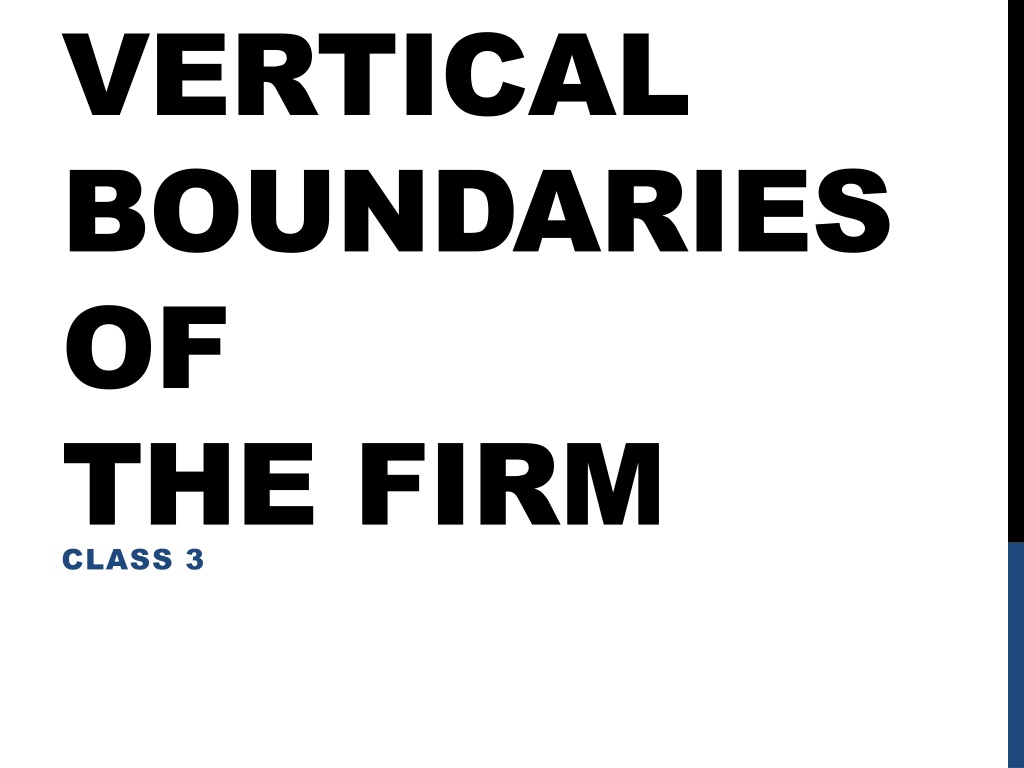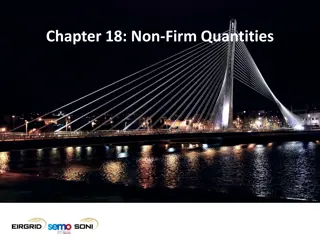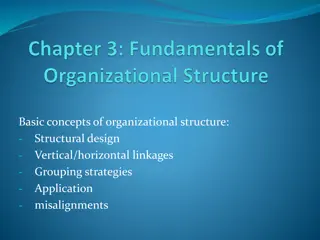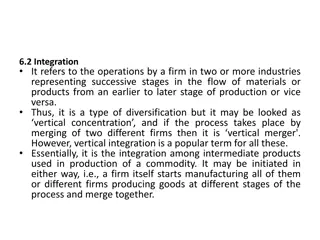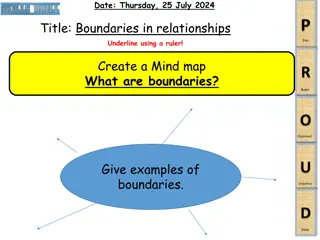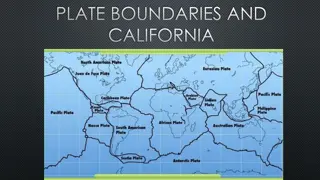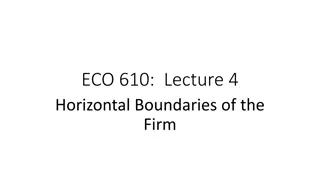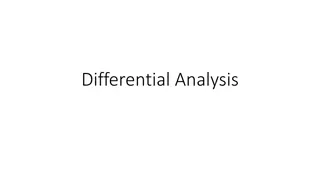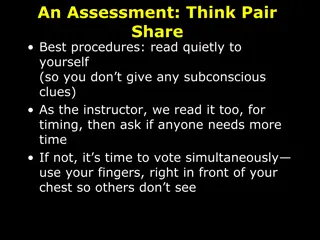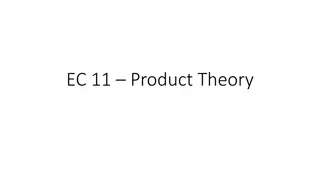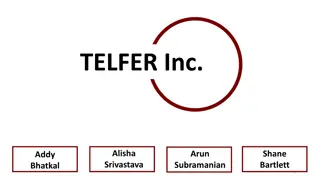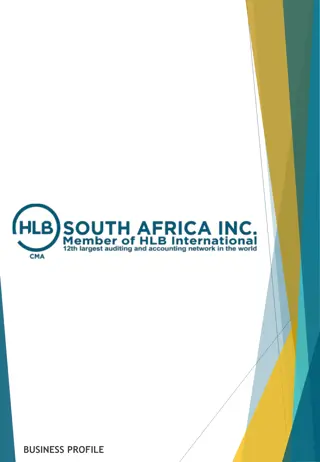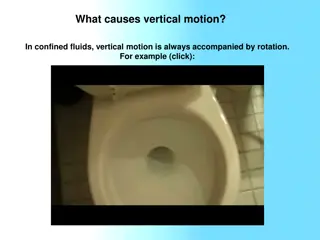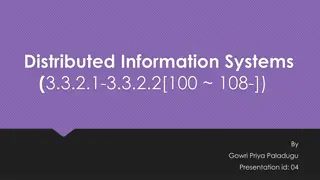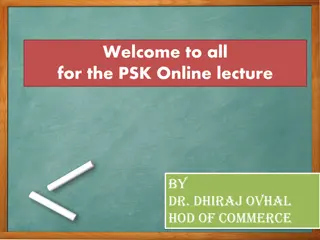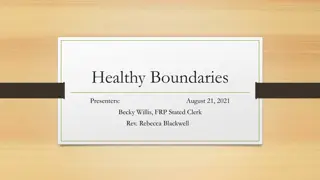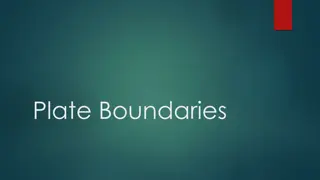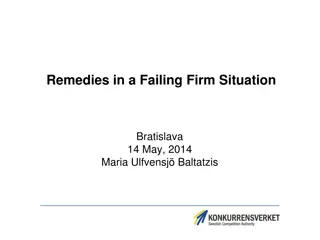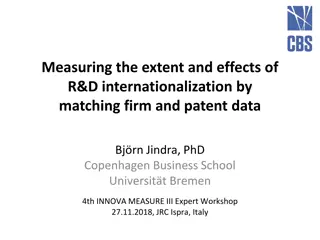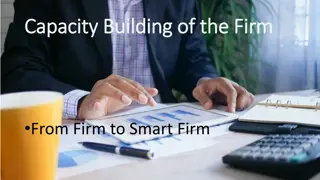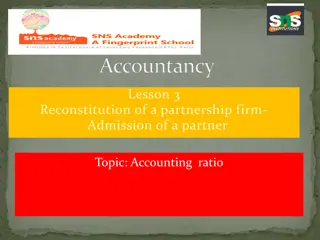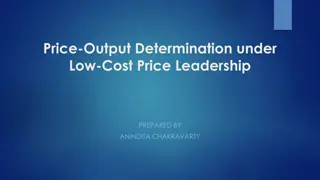Vertical Boundaries of the Firm Class 3 - Make vs Buy Decision Analysis
Exploring the vertical boundaries of firms in Class 3, this content discusses the critical decision-making process between making or buying activities. It covers the concepts of upstream and downstream activities, benefits, costs of using the market, common fallacies related to make or buy decisions, and a case study on whether to make or buy employees. The content emphasizes strategic considerations in determining the most efficient approach for a firm.
Download Presentation

Please find below an Image/Link to download the presentation.
The content on the website is provided AS IS for your information and personal use only. It may not be sold, licensed, or shared on other websites without obtaining consent from the author. Download presentation by click this link. If you encounter any issues during the download, it is possible that the publisher has removed the file from their server.
E N D
Presentation Transcript
VERTICAL BOUNDARIES OF THE FIRM CLASS 3
MAKE VS BUY o A firms decision to perform an activity itself or to purchase it from an independent firm is called a make or buy decision o All services can be done in house or out sourced. oAdvertising oRaw Material Acquisition oLogistics oCustomer Care oWarehousing oRecruitment oMake or buy are two extremes. They are a continuum of possibilities for vertical integration. oClose to make firms can spin off subsidiaries oClose to buy firms can go into long term contracts
UPSTREAM AND DOWNSTREAM oGoods in a production process flow along a vertical chain oFrom raw materials to component parts, to manufacturing through distribution and retailing. oThe early steps are called Upstream , the later steps are Downstream oLumber used to make wooden furniture used to flow from upstream timber forests to down stream mills. Strategic Alliances and Joint Ventures Arms Length Market Transactions Parent Subsidiary Relationships Perform activity Internally Long term contracts Less Integrated >>>>> More Integrated
BENEFITS AND COSTS OF USING THE MARKET -Benefits - Market firms can achieve economies of scale. - Market firms are subject to the discipline of the market and must be efficient in order to survive. -Costs - Coordination of production flows through the vertical chin maybe compromised. - Private information maybe leaked. - Costs of transactions with independent firms that can be avoided by performing the activity in house.
5 MAKE OR BUY FALLACIES 1. Firms should make an asset rather than buy it, if that asset is a source of competitive advantage to the firm. 2. Firms should buy, rather than make, to avoid the costs of making the products 3. Firms should backward integrate to capture the profits of our suppliers for ourselves. 4. By vertically integrating the firm can obtain inputs at cost , thereby avoiding the risk of high input prices. 5. Firms should make rather than buy a distribution channel to gain market share at the expense of rivals.
CASE STUDY MAKE VS BUY EMPLOYEES Firms can choose to make their employees or buy their employees. Making employees will result in training costs, but also giving skills that are needed just for the job in hand. Whereas, buy employees is cheaper but then you have to pay a higher wage than buying a school leaver and training them? 1. If you had a company would you make or buy your employees? 2. What type of employees should you make? 3. What type of employees would be more cost efficient to buy? 4. What are the deciding the factors between buying an employee or making one?
WHY BUY Conventional wisdom that firms should focus their activities on what they do best and leaving else to market firms 1. Market firms may possess propriety information or patents that can enable them to produce at lower costs. 2. Market firms maybe able to aggregate the needs of many customers, thereby enjoying economies of scale. 3. Market firms might exploit their experience in producing for many customers to obtain learning economies.
BUREAUCRACY EFFECTS -Analyst s stage that large firms suffer from bureaucracy. This means one of two problems - Agency Costs - Managers and workers make many decisions that contribute to the profitability of a firm. - Those who knowingly do no act in the best interest of the firm are SHIRKING. - Agency costs are the costs associated with shirking. -Influence Costs - Basically office politics - Therefore, top management does not know who is profitable and are influenced to make decisions that detrimental to the organization but good for the individual.
CASE STUDY - SONY Sony was a household name in the 1990 s with their walkman, and pushing the DVD standard. In 1998 they vertically integrated to software by buying Columbia Records which they renamed Sony Home Entertainment (SHE) Apple then launched the Ipod which Sony responded with launching the Connect. The people running the Connect did not have control of SHE or the Walkman group, or the people who were doing Sony software on the Personal computer. This resulted in the Connect being a terrible failure. The walkman group refused to change their proprietary format to .mp3 as the connect team wanted to which meant that their product was inferior. SHE refused to make their online store user friendly because they were afraid of piracy. Which meant the Apple Store was far superior. All of this meant that SHE, Walkman, Connect all had to be retrenched or shutdown completely. 1. How do you prevent the above from happening?
WHY MAKE? -The Economic Foundation of Contracts -Complete vs Incomplete contracting - Bounded Rationality - Difficulties specifying or measuring performance. - Asymmetric information -Coordination of production flows through the vertical chain - Timing Fit - Sequence Fit - Technical Specification Fit - Colour Fit -Leakage of Private information -Transaction Costs -The Holdup Problem
THE ECONOMIC FOUNDATION OF CONTRACTS Contracts define the conditions of exchange. They maybe standardized like the back of an airline ticket or an invoice or Complicated like the sale of the Empire State Building in the 1960 s that had over 400 pages and over 100 lawyers were involved. Why are contracts important? Contracts can be used to reduce shirking, but this depends on the 1. Completeness of the contract 2. The available body of contract law.
COMPLETE VS INCOMPLETE CONTRACTING Complete contracts cover all foreseeable outcomes. They specify everything. Most real world contracts are incomplete. Reasons why most contracts are incomplete. 1. Bounded Rationality refers to the limits on the capacity of individuals to process information, deal with complexity and pursue rational aims 2. Difficulties specifying or measuring performance refers to when performance is complex or subtle not even the most accomplished wordsmiths can be clear on what is the fulfillment of the contract. 3. Asymmetric information means that one group knows more about an activity than the other group. Therefore, they know how to protect themselves.
COORDINATION OF PRODUCTION FLOWS THROUGH THE VERTICAL CHAIN Timing Fit The launch of a Heineken marketing campaign must coincide increase production and distribution by its bottlers. Sequence Fit The steps in a medical treatment protocol must be properly sequenced. Technical Specification Fit The sun roof of a car must fit precisely into the roof opening Colour Fit The tops of the Benetton s Spring Line up must match the bottoms.
LEAKAGE OF PRIVATE INFORMATION Give examples of private information? For each example explain what can be done with that information, and how damaging could it be?
TRANSACTION COSTS The concept of transaction costs was first described by Ronald Coase in his paper The Nature of the Firm He asked the question, in light of the efficiencies of the market, why do firms do so much economic activity within the firm? He concluded that there must be costs to using the market that can be eliminated by using the firm i.e. Transaction Costs There was a new branch of economics called Transaction Cost economics. The adverse consequences of opportunistic behaviour. The costs of preventing opportunistic behaviour
HOMEWORK 1. Influence activities can happen in everyday life, in household, schools, and even among close friends Can you give examples to support this statement? 2. Describe the vertical chain of a company that manufactures toffees and sells them in the Sri-Lankan Market? 3. Why do Keells, Cargills and other supermarkets have store brands for commodities. How do they get these products? Are they vertically integrated?
